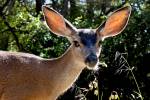Technology blurs lines of fair chase
Fair chase. In hunting circles, these words have been bandied about in recent years, especially with the tide of high-tech products flooding the outdoor marketplace. From local gun clubs to online forums, those participating in fair chase discussions are struggling with the question of how much technology is too much.
Perhaps the place to start the discussion is with the principle of fair chase.
"Fundamental to ethical hunting is the idea of fair chase. This concept addresses the balance between the hunter and the hunted. It is a balance that allows hunters to occasionally succeed while animals generally avoid being taken," Jim Posewitz wrote in his book, "Beyond Fair Chase: The Ethic and Tradition of Hunting."
Posewitz, founder of Orion The Hunter's Institute, added, "There are some activities that are clearly unfair as well as unethical."
The next question: What constitutes fairness?
When my sister first moved to Texas, she told me how local hunters used feeders and elevated blinds to hunt deer. She felt it was unethical and unfair because it is different than what we do farther west. On my recent trip through Texas, however, I saw the feeders and the elevated blinds. Both generally were associated with areas where the brush and tree canopy was so dense that hunting would be impractical and perhaps unsafe otherwise.
According to James Tantillo, executive director at Orion, "Most of what passes for 'hunting ethics' today is really hunting aesthetics. I believe when hunters speak of a right way or a wrong way to hunt, they generally mean something more like the way I like to hunt versus the way you like to hunt."
In recent years, the use of trail cameras - trail cams - to locate and pattern big-game animals has exploded across the country. In Southern Nevada, I have heard from hunters and professional guides that multiple cameras are on every water source, natural or man-made. Products that started out as simple cameras whose shutter was tripped by movement in the target area have evolved to include cameras with the capability of sending real-time images to one's computer or cellphone. (It makes you want to think twice about changing your clothes in the wild.)
For hunting purposes, these cameras can save time and money, but does their use violate the rules of fair chase? Something else to think about is the impact of the growing number of trail cam users - hunters and nonhunters alike - on the wildlife resource.
"Their increased use has the very real potential of severe impacts to wildlife," the Lincoln County Advisory Board to Manage Wildlife wrote in a recent letter to Nevada's Board of Wildlife Commissioners. "Stories of 70 cameras found in the Gregorson Basin area, a dozen cameras on one spring, guides placing 50-70 cameras within the area for the purpose of scouting ... one begins to wonder how much stress is added to animals trying to use isolated springs when so many people are installing, checking and removing cameras; not to mention how an animal reacts to a dozen cameras clicking and flashing when it comes in to drink."
In the late 1990s, I read an article written by a Wyoming game warden who was nearing the end of his career. Though I since have forgotten the author's name, the premise of his article has remained with me. His words were the lamentations of one who had witnessed what he viewed as the replacement of woodsmanship with technology, the replacement of skills historically developed only by spending time in the wild with store-bought gadgetry.
The challenge for us is choosing the technology that maintains the traditional challenges, woodsmanship skills and physical aspects of hunting in the sport.
As Posewitz wrote, "In addition to hunting practices, there is a constant flow of products developed to provide advantages to hunters. Sights, scents, calls, baits, decoys, devices and techniques of infinite variety fill the marketplace.
"In each case an individual choice must be made as to what sustains fair chase and what violates that concept."
Freelance writer Doug Nielsen is a conservation educator for the Nevada Department of Wildlife. His "In the Outdoors" column, published Thursday in the Las Vegas Review-Journal, is not affiliated with or endorsed by the NDOW. Any opinions he states in his column are his own. He can be reached at intheoutdoorslv@gmail.com.























